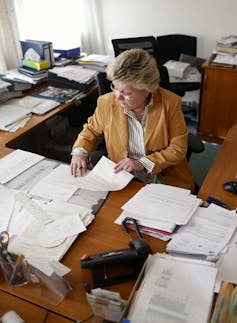Grandparents are the most popular providers of childcare in Australia today. This reliance on them exposes weaknesses in current labour market and childcare policies.
Increasing workforce participation by mothers and older people have been the dual goals of policy for some time, particularly as the population ages. What is overlooked is that these policy priorities place increasing, and competing, pressures on one group of older Australians – grandparents who provide childcare.
Boosting workforce participation among women and older people is essential to Australia’s future prosperity, according to the 2015 Intergenerational Report. In a speech the week before its release, the then-treasurer, Joe Hockey, said:
How can we contribute more and get more from a nation that has given us much over such a long period of time?
Increasing the workforce participation of women and older Australians, Hockey said, can provide a huge boost to our economy.
But that participation depends heavily on the childcare that grandparents provide. In 2014, approximately 837,000 children received childcare from their grandparents. This is many more children than in any other form of care, including long day care or before- and after-school care. Grandmothers provided most of this childcare.
Increased maternal labour market participation, coupled with a lack of affordable and available formal childcare, is likely to result in continued reliance on grandparents for childcare.
At the same time, measures to boost employment and delay retirement among mature-age Australians place pressure on many grandparents to work longer and harder. The former policy priority places pressure on grandparents to provide more care; the latter asks them to undertake more work.
Grandparents reorganise own working lives
How do grandparents perceive and navigate the twin demands of childcare provider and mature-age worker? New research I conducted with my colleague Bridget Jenkins for the National Seniors Productive Ageing Centre suggests that many grandparents who regularly care for their grandchildren reorganise their working lives considerably to do so.
Among those surveyed, 70% altered the days or shifts they work, 55% reduced their working hours and 18% even changed their job because of their caring commitment. In addition, grandparents regularly accommodate atypical, short-notice requests for care – such as when a child is sick or a parent is suddenly called into work.
Their care commitments also affect the way they use their workplace entitlements. Many organise their leave or request flexible work arrangements to accommodate the care of grandchildren. More than 40% reported finding it difficult to juggle the competing demands of work and care.

One-third of grandparents surveyed also reported that their childcare commitment changed the timing or expected timing of their retirement. For many others, while providing regular childcare is not the only factor, it figures heavily in shaping their decision to retire.
Significantly, most grandparents said they provided this care, and adjusted their work accordingly, to enable their children, particularly daughters and daughters-in-law, to participate in work.
The dual policy priorities of boosting paid work among mothers and older people therefore create tensions for grandparents faced with competing demands. Many go to considerable lengths to be able to provide the care their children require while also remaining in work. Grandmothers, who provide most of the childcare, probably feel these tensions most strongly.
The research also revealed an “intergenerational trade-off” that challenges these dual policy priorities. This trade-off is heavily gendered. Mature-age grandparents, mostly grandmothers, are adjusting or reducing their own workforce participation to help their daughters and daughters-in-law participate in the workforce.
In other words, one generation of women is reducing their workforce participation to support the participation of another.
A massive policy blindspot
In spite of the huge contribution grandparents make in supporting families to work, and the considerable impacts this has on their own patterns of work, the 2015 Intergenerational Report completely overlooked grandparent childcare. Nor was it acknowledged in public discussion of the report, or in any previous intergenerational report.
The role of grandparents in childcare is also invisible in all of the most relevant policy spheres. This affects not just maternal and mature-age employment policy but early childhood education and care and retirement incomes policies too.
As a result, current policy is blind to the potential intergenerational impacts of meeting the desired goals. If we achieve the 2015 Intergenerational Report’s objective of boosting workforce participation by both mothers and grandparents, what will be the implications for childcare demand and supply?
What’s more, policy is being formulated on the basis of incomplete information about the conditions facing Australian families and shaping their decisions about work and childcare.
Recognising the importance of childcare provision in the work and retirement decisions of grandparents is essential in the design of effective mature-age employment and retirement incomes policies. And understanding the role that grandparents play in families’ decisions about work and childcare is essential to the design of effective maternal employment and childcare policies.
In a ministerial statement on the 2015 Intergenerational Report, Hockey said:
The Intergenerational Report is the social compact between the generations – children, grandchildren, parents, grandparents and each other.
Grandparents are central to Australia’s social compact. They make a fundamental contribution to families and to our social and economic fabric. It’s time to recognise what grandparents do and to adjust policy frameworks to account for their important role.

